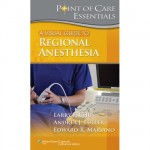 The textbook Essentials of Regional Anesthesia is now available from online booksellers. All of the chapters are written by Regional Anesthesia fellowship directors and fellows and cover various topics including regional anesthesia procedures and acute pain management for complex patients of all ages and various co-morbidities. This book is full of clinical pearls and also includes over 400 test questions based on the book’s content to assess your knowledge of the subject matter. My chapter, co-authored by my wife who has been educating nurses on regional anesthesia techniques and acute pain management for years, focuses on the practice management aspects of regional anesthesia and offers strategies to develop effective systems that emphasize teamwork with all providers involved in caring for the perioperative patient.
The textbook Essentials of Regional Anesthesia is now available from online booksellers. All of the chapters are written by Regional Anesthesia fellowship directors and fellows and cover various topics including regional anesthesia procedures and acute pain management for complex patients of all ages and various co-morbidities. This book is full of clinical pearls and also includes over 400 test questions based on the book’s content to assess your knowledge of the subject matter. My chapter, co-authored by my wife who has been educating nurses on regional anesthesia techniques and acute pain management for years, focuses on the practice management aspects of regional anesthesia and offers strategies to develop effective systems that emphasize teamwork with all providers involved in caring for the perioperative patient.
Tag Archives: regional anesthesia
Point of Care Resource for Regional Anesthesia
 The Visual Guide to Regional Anesthesia
The Visual Guide to Regional Anesthesia
This companion to the recently-released Manual of Clinical Anesthesiology (Chu and Fuller, eds.) focuses on what the clinician needs to know when performing the latest ultrasound-guided regional anesthesia procedures. The format of this book is compact and spiral bound, filled with useful cognitive aids, and each page is laminated to make it fluid-proof (perfect for the operating room).
Related Posts:
Stanford Regional Anesthesiology and Acute Pain Medicine Fellowship
 The application cycle for the 2014-15 Stanford Regional Anesthesiology and Acute Pain Medicine Fellowship class is still open for 1 off-cycle spot scheduled to start in Winter 2015. The application cycle for 2015-16 is also open now and will remain open until Summer 2014. I co-direct this training program along with Dr. Lindsey Vokach-Brodsky. In addition to being the only fellowship in this specialty located in Northern California, the Stanford program provides its fellows with a unique training experience in a beautiful setting. Throughout the training year, various clinical rotations at Stanford Medical Center, Stanford Medicine Outpatient Center, and the VA Palo Alto immerse fellows in an environment focused on teaching them advanced regional anesthesia techniques and perioperative pain medicine. Fellows have ample opportunity to participate in clinical research projects and to teach basic and intermediate techniques to residents and other practitioners at educational workshops and study anatomy in the cadaver lab.
The application cycle for the 2014-15 Stanford Regional Anesthesiology and Acute Pain Medicine Fellowship class is still open for 1 off-cycle spot scheduled to start in Winter 2015. The application cycle for 2015-16 is also open now and will remain open until Summer 2014. I co-direct this training program along with Dr. Lindsey Vokach-Brodsky. In addition to being the only fellowship in this specialty located in Northern California, the Stanford program provides its fellows with a unique training experience in a beautiful setting. Throughout the training year, various clinical rotations at Stanford Medical Center, Stanford Medicine Outpatient Center, and the VA Palo Alto immerse fellows in an environment focused on teaching them advanced regional anesthesia techniques and perioperative pain medicine. Fellows have ample opportunity to participate in clinical research projects and to teach basic and intermediate techniques to residents and other practitioners at educational workshops and study anatomy in the cadaver lab.
If you are interested in applying, please see the Stanford Anesthesia website for further information. To compare programs, visit ASRA.com.